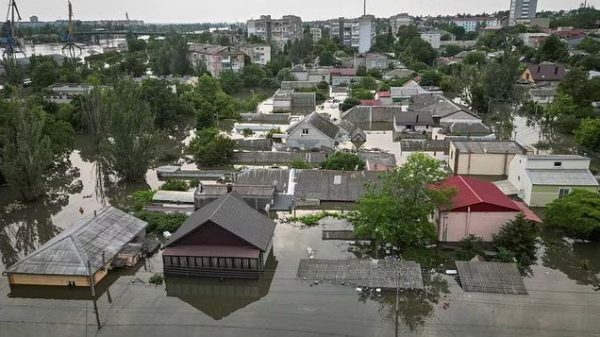Ukrainians face homelessness, disease risk as floods crest from burst dam

- Update Time : Thursday, 8 June, 2023, 01:02 pm
- 183 Time View

Online Desk: Ukrainians abandoned inundated homes as floods crested across a swathe of the south on Wednesday after the destruction of a huge hydro-electric dam on front lines between Russian and Ukrainian forces, with their presidents trading blame for the disaster. Residents slogged through flooded streets carrying children on their shoulders, dogs in their arms and belongings in plastic bags while rescuers used rubber boats to search areas where the waters reached above head height.
Ukraine said the deluge would leave hundreds of thousands of people without access to drinking water, swamp tens of thousands of hectares of agricultural land and turn at least 500,000 hectares deprived of irrigation into “deserts”, reports Reuters.
Visiting the city of Kherson downstream from the dam, Deputy Prime Minister Oleksandr Kubrakov said over 80 settlements had been affected by the disaster, and that the flooding had loosened chemicals and infectious bacteria into the water. The Nova Kakhovka dam collapse on Tuesday coincides with a looming, long-vaunted Ukrainian counteroffensive against Russia’s invasion, likely the war’s next major phase. Both sides traded blame for continued shelling across the populated flood zone and warned of drifting landmines unearthed by the flooding. “Water is disturbing mines that were laid earlier, causing them to explode,” Kubrakov said.
Kyiv said on Wednesday its troops in the east had advanced by more than a kilometre around the ruined city of Bakhmut in eastern Ukraine, its most explicit claim of progress since Russia reported the start of the Ukrainian counteroffensive earlier this week. Russia said it had fought off the assault. Oleksiy Danilov, secretary of Ukraine’s national security council, said assaults under way were still localised, and the full-scale offensive had yet to begin. “When we start (it), everyone will know about it, they will see it,” he told Reuters.
Kyiv said several months ago the dam had been mined by Russian forces that captured it early in their 15-month-old invasion, and has suggested Moscow blew it up to try to prevent Ukrainian forces crossing the Dnipro in their counteroffensive. Ukrainian President Volodymyr Zelensky called the destruction of the Soviet-era dam “an environmental bomb of mass destruction” and a war crime, saying Russia had blown up the complex’s power plant from within.
Russian President Vladimir Putin accused Ukraine of destroying the dam at the suggestion of Western supporters, saying it was a “barbaric” war crime that escalated the conflict with Moscow. Putin described the incident as an “environmental and humanitarian catastrophe”, according to a Kremlin read-out. Neither side has presented public evidence demonstrating who was responsible. Some experts say the dam may have collapsed due to earlier war damage and poor Russian management.
‘THEY HATE US’
Residents on the government-controlled side of the flood zone in the south, a fertile, marshy region stretching to the Dnipro estuary on the Black Sea, blamed the bursting of the dam on Russian troops who held it on the eastern bank of the Dnipro. “They hate us,” said riverside villager Oleksandr Reva. “They want to destroy a Ukrainian nation and Ukraine itself. And they don’t care by what means because nothing is sacred for them.”
Russia imposed a state of emergency in the areas of Kherson province it controls, where many towns and villages lie in exposed lowlands below the dam. In the town of Nova Kakhovka right next to the dam, brown water submerged main streets largely empty of residents.
Over 30,000 cubic metres of water were gushing out of the dam’s reservoir every second and the town was at risk of contamination from the torrent, Russia’s TASS news agency quoted the Russian-installed mayor, Vladimir Leontyev, as saying. Zelensky also said he was “shocked” at what he called the lack of UN and Red Cross aid so far for victims of the disaster, and Prime Minister Denys Shmyhal urged international humanitarian organisations to step up urgently.
Shortly afterward, President Emmanuel Macron of France said on Twitter that “within the next few hours we will send aid to meet immediate needs”. The UN’s humanitarian affairs office said a team was in Kherson to coordinate relief efforts. Access to drinking water was a major concern and around 12,000 bottles of water and 10,000 purification tablets had been distributed so far.
Ukraine expects the floodwaters will stop rising by the end of Wednesday after reaching around five metres (16.5 feet) overnight, presidential deputy chief Oleksiy Kuleba said. Two thousand people have been evacuated from the Ukrainian-controlled part of the flood zone and waters had reached their highest level in 17 settlements with a combined 16,000 people.
DAM CRUCIAL TO GRAIN PRODUCTION
The mighty Dnipro River that bisects Ukraine forms the front line across the south. The huge reservoir behind the dam was one of Ukraine’s main geographic features, and its waters irrigated large areas of one of the world’s leading grain-exporting nations, including Crimea, seized by Russia in 2014. “The sheer magnitude of the catastrophe will only become fully realised in the coming days,” United Nations aid chief Martin Griffiths told the U.N. Security Council.
Even with the evacuation under way, Russia shelled Ukrainian-held territory across the river. Crumps of incoming artillery sent people running for cover in Kherson.
For its part, Russia said a Ukrainian drone had struck a town on the opposite bank during evacuations there and accused the Ukrainian side of continuing shelling despite the flooding.










